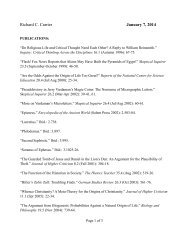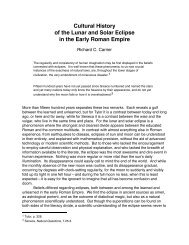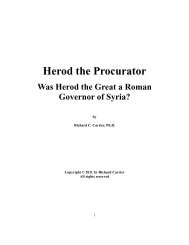“Bayes' Theorem for Beginners: Formal Logic and ... - Richard Carrier
“Bayes' Theorem for Beginners: Formal Logic and ... - Richard Carrier
“Bayes' Theorem for Beginners: Formal Logic and ... - Richard Carrier
Create successful ePaper yourself
Turn your PDF publications into a flip-book with our unique Google optimized e-Paper software.
comparable to it would exist) if the hypothesis we are testing is false, but all our<br />
background knowledge is still true (i.e. everything else we know about the world,<br />
about people, about the time <strong>and</strong> place in question, etc.). This equals the posterior<br />
probability of the evidence if some hypothesis other than h is true, <strong>and</strong> if there is<br />
more than one viable contender, you can include each competing hypothesis<br />
independently (per above) or subsume them all under one group category (~h).<br />
= [hereafter I call this the consequent probability]<br />
9. Bayes’ <strong>Theorem</strong> (Abbreviated)<br />
P(h|b) x P(e|h.b)<br />
P(h|e.b) = ________________________<br />
P(e|b)<br />
Note that P(e|b) = [ P(h|b) x P(e|h.b) ] + [ P(~h|b) x P(e|~h.b) ] so I recommend the longer<br />
<strong>for</strong>m instead, as a check against error (especially that of assuming P(e|b) = P(e|~h.b)).<br />
10. Employing Bayes’ <strong>Theorem</strong><br />
If we use Bayes’ <strong>Theorem</strong> to determine the likelihood that Jerusalem had a public library,<br />
<strong>and</strong> if the following data is the same (note that this model of the problem <strong>and</strong> these<br />
percentages are deliberately unrealistic—realistically they should all be much higher, <strong>and</strong><br />
the evidence is more complicated):<br />
60% chance that any major city in antiquity had a public library<br />
90% chance that Jerusalem was a major city<br />
60% chance that there was a library if there is a document attesting to a library<br />
90% chance that we have a document attesting to a public library in Jerusalem<br />
P(h|b) = (0.6 x 0.9) + x = 0.54 + x = The prior probability that Jerusalem was a major city<br />
<strong>and</strong> (as such) would have a public library (based on our background knowledge alone, i.e.<br />
what we know of other cities <strong>and</strong> of the archaeological <strong>and</strong> textual evidence of the size<br />
<strong>and</strong> success of Jerusalem as a city). The added factor x is the prior probability that<br />
Jerusalem had a public library even if it wasn’t a major city. Here <strong>for</strong> simplicity this is<br />
arbitrarily assumed to be zero, but realistically it needn’t be. And if it wasn’t, x would<br />
equal 0.1 x y, where 0.1 is the probability that Jerusalem wasn’t a major city (i.e. the<br />
converse of the probability that it was, i.e. 0.9) <strong>and</strong> y is the probability of a non-major<br />
city having a public library (whatever we deemed that to be from available evidence).<br />
P(~h|b) = 1 – 0.54 = 0.46 = The prior probability that Jerusalem did not have a public<br />
library = the converse of the other prior (i.e. all prior probabilities that appear in a<br />
Bayesian equation must sum to exactly 1, no more nor less, because together they must<br />
encompass all possible explanations of the evidence <strong>for</strong> Bayes’ <strong>Theorem</strong> to be valid).<br />
16








